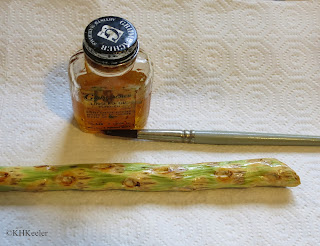I’m making a short video about the fact that the vegetables cabbage, broccoli, Brussels sprouts, cauliflower and kale are all botanically the same, Brassica oleracea (cabbage family, Brassicaceae). The oddest fact I plan to include is that in the 18th and 19th centuries, on the islands of Jersey and Guernsey in the English channel, the cabbages grew to 20' tall and their stalks were dried, varnished and used as walking sticks. LINK
People on the Channel Islands raised cattle as well as cabbages and broke off the big lower leaves to feed their cows. In the cool, moist climate--perfect for cabbage plants--the plants grew taller and taller, while people picked off more lower leaves. Since the growing season is long and the frosts light, the cabbage plants sometimes reached twenty feet tall, with big cabbage leaves at the top. They looked from a distance like palm trees.
The stems were pretty tough, so when the plant died, the resourceful islanders found a variety of uses for them. One was to dry, smooth, and varnish the cabbage stems and use them for canes or walking sticks.
Time and change has mostly eliminated both the giant cabbages and the walking stick industry, but they still make a few (Note: 2/1/21: having gained attention, Jersey residents are making more walking sticks. link)
 |
| Brussels sprouts |
I wanted to show a picture of the canes in the video but I wasn't sure about copyright issues on the pictures I found.
But, in preparing to talk about Brussels sprouts, I bought Brussels sprouts on the stalk late this summer.
 |
| Close up of Brussels sprouts on stalk |
 |
| Brussels sprout stalk |
We ate the Brussels sprouts, leaving the stalk.
 |
| Brussels sprout stalk 2nd angle |
Hmmm...If both cabbages and Brussels sprouts are Brassica oleracea, shouldn't the Brussels sprout stalk be very much like the cabbage stalks used for walking canes?
With that in mind, I saved the Brussels sprout stalk. I let it dry in my office for a couple months. The references for Jersey kale walking canes say dry for two years, so I didn't do it right. But it was not very thick and Colorado has very low humidity.
 |
| Brussels sprout stalk after sanding |
Obviously (see photo) it needed smoothing. Sheron Buchele Rowland, finding walking canes from cabbage charmingly bizarre, talked me into sanding it on the belt sander at Ildanach Studios. The dust from sanding a Brussels sprout stalk smells really funny. Like cabbage, actually.
 |
| partly varnished Brussels sprout stalk |
Next was varnish. I put linseed oil on it.
 |
| varnished Brussels sprouts stem |
 |
| starting to look like the walking stick pictures |
It is too short to be a walking stick of course. Magic wand? See video at top of post.
The Brussels sprout stick certainly lets you better imagine the historical cabbage walking sticks!
References
Walking sticks as seed savers--the case of the Jersey kale [Brassica oleracea L. convar. acephala (D.C.) Alef. var. viridis L.) Economic Botany 54 (2): 141-143 (2000)
and the websites linked to, above.
Kathy Keeler
more at http://awanderingbotanist.com
Join me on Facebook: https://www.facebook.com/AWanderingBotanist
Here is the link to the video I was making when I needed a Brussels sprouts stick cabbages
No comments:
Post a Comment